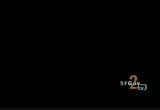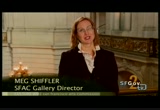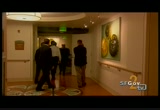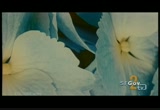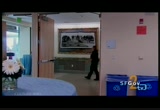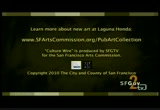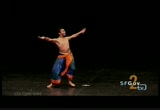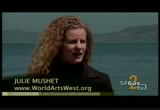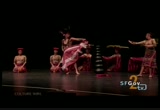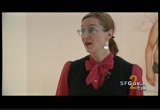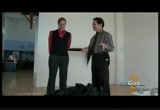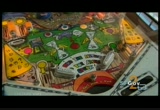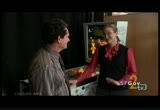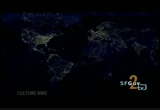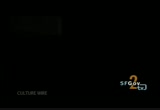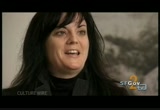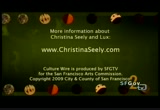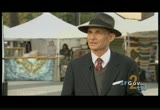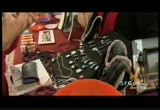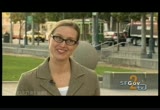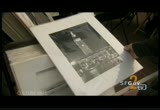tv [untitled] July 13, 2011 9:30pm-10:00pm PDT
9:31 pm
we're going to take a look at one of the biggest and most significant public art projects today. ♪ on june 26, mayor newsom and other officials gathered at the hospital to cut the ribbon and welcome the public into a beautiful new state-of-the-art facility. >> 3, 2, 1. [applause] >> in has been 10 years since voters approved the measure for the new building. >> when they cast the vote, we have an exciting opportunities to rethink how art is done in a hospital setting.
9:32 pm
>> replacement program generated approximately $3.9 million in art enrichment funds for a comprehensive art program that contributes to the quality of life at the hospital by enhancing the environment and supporting the hospital's needs and therapeutic goals. artists were commissioned to create 100 original works of art. as was for the gardens and courtyard areas. >> be artwork does more than just hang on the wall. it will enhance the therapeutics of the hospital and will include sensory stimulation, orientation, social interaction.
9:33 pm
>> it was set into like boxes to create color filled areas in the hospital. inspired by nature, the signature painting of native san francisco birds, clouds, and the surface of the ocean waves were translated into a variety of media including glass mosaic and tapestry. the playful clock encourages memory stimulation among the patients. they used the theme of the four elements as they relate to vocation. it is a direct homage to the historical murals in the original laguna honda building. it features to large tile walls.
9:34 pm
by observing residents, the gardens created a public artwork in the form of the handrail. in one of the outdoor courtyards, the circular grouping of -- with a smooth finish. this features ten unique button sculptures with different pastel colors that function not only as a place to sit, but also as a touchstone to something recognizable, familiar, and comforting. another key component included an art project that responded directly to the hospital's rich history. using archival images and artifacts, had designed 16
9:35 pm
intricately woven tapestries that are inviting of significant events that shaped the hospital and the community over time. a >> it attracts a lot of visitors, and they are all and all - -in aw -- in awe over the variety of mediums used. >> i think we have given the city of san francisco and the residents an incredible art collection. it really encourage people to come and visit the new facility, also to see the arts. >> for more information, visit
9:36 pm
sfartscommis >> the san francisco ethnic dance festival is one of the jewels on san francisco sculptural crowns. this is in its 32nd year of showcasing the celebrated dance troupes. this year will be one of the past with four new works representing kondo, afghanistan, china, mexico. -- congo, afghanistan, china, mexico. more than a hundred 30 ensembles and soloists auditioned in january for a slot in the ethnic dance festival. in the end, 37 companies were
9:37 pm
selected to perform. 26 of those performances are world premieres. >> each year, we assembled a panel of dance experts that is made up of academics, scholars, researchers. people have been working for decades in the field. many of them came to this country in the seventies and have trained the next generation of dancers. they are proud to see many of these students at the these masterful levels. this was one of the best panel'' we have ever had, extraordinary people. at the end of the process, they rank their top groups which are then merged into a master list. >> performers are judged on
9:38 pm
stage presence, costumes, and innovation. >> the four programs are created around an exciting and dynamic range so the soloists and groups selected each weekend will have enough dynamic range to be a society overall to are experience. >> hundreds of dancers from different countries need each other, compare stuff, and make new friends. this has resulted in new cross- cultural collaborations'. >> one of the extraordinary things is that it really only happens here in the san francisco bay area. all of the dancers that we are presented -- presenting are from the area. they have full-time jobs and
9:39 pm
they spend their weekends nurturing their passion to sustain these extraordinary dance forms from around the world. the audience cannot help but be inspired. >> this year, the festival will feature a special collaboration that celebrates the mexican bicentennial and commemorates the 100th anniversary of the mexican revolution. >> one of the great area biographers has stepped out of that role and we asked them to create a special work working with 6 x ordinary dance companies that we have assembled dancers from all of these companies to present a united work in celebration of the bicentennial. >> dancers from over 20 countries are staunch cultures
9:40 pm
are participating. >> one of the things that is inspiring is how many are being invited back to their home countries as cultural ambassadors from the u.s.. we are teaching them in committees so that the next generation here in america and back to india or bali or whatever will be able to get enriched by these very beautiful art forms. >> thank you for watching "culture wire." and you can find more information
9:41 pm
>> i'm your host of "culturewire," and today, here at electric works in san francisco. nice to see you today. thanks for inviting us in and showing us your amazing facility today. >> my pleasure. >> how long has electric works been around? >> electric works has been in san francisco since the beginning of 2007. we moved here from brisbane from our old innovation. we do printmaking, gallery shows, and we have a fabulous retail store where there are lots of fun things to find. >> we will look at all of that as we walk around. it is incredible to me how many different things you do. how is it you identify that san francisco was in need of all these different services? >> it came from stepping out of graduate school in 1972. i wrote a little thing about how this is an idea, how our world
9:42 pm
should work. it should have printmaking, archiving, a gallery. it should have a retail store. in 1972, i wanted to have art sales, point-of-sale at the grocery store. >> so you go through the manifesto. with the bay area should have. you are making art incredibly accessible in so many different ways, so that is a good segue. let's take a walk around the facilities. here we are in your gallery space. can you tell me about the current show? >> the current show is jeff chadsey. he is working on mylar velum, a smooth, beautiful drawing surface. i do not know anyone that draws as well as he does. it is perfect, following the contours and making the shape of the body. >> your gallery represents
9:43 pm
artists from all over, not just the bay area, an artist that work in a lot of different media. how to use some of what you look for in artists you represent? >> it is dependent on people are confident with their materials. that is a really important thing. there is enough stuff in the world already. >> you also have in his current show an artist who makes sculpture out of some really interesting types of materials. let's go over and take a look at that. here we are in a smaller space. project gallery. >> artists used the parameters of this space to find relationships between the work that is not out in the big gallery. >> i noticed a lot of artists doing really site-specific work. >> this is a pile of balloons, something that is so familiar, like a child's balloon.
9:44 pm
in this proportion, suddenly, it becomes something out of a dream. >> or a nightmare. >> may be a nightmare. >> this one over here is even harder to figure out what the initial material is. >> this is made out of puffy paint. often, kids use it to decorate their clothes. she has made all these lines of paint. >> for the pieces we are looking at, is there a core of foam or something in the middle of these pieces that she built on top of? >> i'm not telling. >> ah, a secret. >> this silver is aluminum foil, crumbled of aluminum foil. her aesthetic is very much that quiet, japanese spatial thing that i really admire. their attention to the materiality of the things of the world. >> this is a nice juxtaposition
9:45 pm
you have going on right now. you have a more established artists alongside and emerging artists. is that something important to you as well? >> very important in this space, to have artists who really have not shown much. now let's look at other aspects of electric works operation. let's go to the bookstore. >> ok. >> in all seriousness, here we are in your store. this is the first space you encounter when you come in off the street. it has evolved since you open here into the most amazingly curious selection of things. >> this was the project for the berkeley art museum. it was -- this is from william wiley's retrospective, when he got up onstage to sing a song, 270 people put on the cat. >> it is not just a bookstore. it is a store.
9:46 pm
can you talk us through some of your favorites? >> these are made in china, but they are made out of cattails. >> these pieces of here, you have a whale head and various animals and their health over there, and they are jewelry. >> we do fund raisers for nonprofits, so we are doing a project for the magic theater, so there are some pretty funny cartoons. they are probably not for prime time. >> you sort of have a kind of holistic relationship where you might do merchandise in the store that promotes their work and practice, and also, prince for them. maybe we should go back and look at the print operation now. >> let's go. >> before we go into the print shop, i noticed some incredible items you have talked back here. what are we standing in front of? >> this is william wiley, only
9:47 pm
one earth. this is a print edition. there are only eight total, and what we wanted to do was expand the idea of printmaking. this is really an art object. there we go. >> besides the punball machine, what do you produce in limited edition? >> there is the slot machine. if you win the super jackpot, you have saved the world. >> what about work? >> the right design, it was three volumes with lithographs in each volume. the cab of count dracula with 20 lithographs inside and lined
9:48 pm
with beaver fur. really special. >> let's move on to the print shop. >> ok. the core of what we do is making things. this is an example. this is a print project that will be a fund-raiser for the contemporary music players. we decided to put it in the portfolio so you could either frame at or have it on your bookshelf. >> so nonprofits can come to you, not just visual are nonprofits, but just nonprofits can come to you, and you will produce prints for them to sell, and the profits, they can keep. >> the return on investment is usually four times to 10 times the amount of investment. this is for the bio reserve in mexico, and this is one of the artists we represent. >> you also make prints for the artists that you represent. over here are some large prints
9:49 pm
by a phenomenal artist. >> he writes these beautiful things. anyone who has told you paradise is a book of rules is -- has only appeared through the windows. this is from all over coffee. we are contract printers for all kinds of organizations all across the country. >> thank you very much for showing us around today. i really appreciate you taking the time to let me get better acquainted with the operation and also to share with our "culturewire" team. >> about four years ago, [inaudible]
9:50 pm
look at how beautiful this was. there is our relationship to the planet. these regions are the wealthiest, the most powerful. that really has impacted the planet. it is almost impossible now to go anywhere and had it really be completely dark. there are very few locations that you can find. that means our relationship to the sky, there is a way where we dominate the sky. we cannot see anything really. we are blinding ourselves in a way.
9:51 pm
>> you can look at the images, they are beautiful. when i started four years ago, there was a conversation about environmental issues that was very different. this is not being talked about in the way it is now. . this has just been like an amazing growth. i anticipate the project to be something that opens a dialogue to public interest in these ideas. so the work is really made to be seen in this environment. it's been show in museum, in
9:52 pm
gallery, but never in a public setting. and it's kind of ideal for both myself and the works to have this real dialogue with the public not only in san francisco but people coming from all over the world. >> since the dawn of electricity, that light is something that people feel connected to and inspired by. personally, there is space to keep that alive, just finding balance. the key is to find some balance.
9:53 pm
>> here we are at the embarcadero. we are standing at one of locations for the street artists. can you tell me about this particular location, the program? >> this location is very significant. this was the very first and only location granted by the board of supervisors for the street artist when the program began in 1972. how does a person become a street artist? there are two major tenants. you must make the work yourself and you must sell the work yourself. a street artist, the license, then submitting the work to a
9:54 pm
committee of artists. this committee actually watches them make the work in front of them so that we can verify that it is all their own work. >> what happened during the holiday to make this an exciting location? >> this would be a magic time of year. you would probably see this place is jammed with street artists. as the no, there is a lottery held at 6 in the morning. that is how sought after the spaces are. you might get as many as 150 street artists to show up for 50 spaces. >> what other areas can a licensed street artist go to? >> they can go to the fisherman's wharf area. they can go in and around union square. we have space is now up in the castro, in fact. >> how many are there? >> we have about 420.
9:55 pm
>> are they here all year round? >> out of the 420, i know 150 to sell all year round. i mean like five-seven days a week. >> are they making their living of of this? >> this is their sole source of income for many. >> how long have you been with this program. how much has it changed? >> i have been with the program since it began 37 and a half years ago but i have seen changes in the trend. fashion comes and goes. >> i think that you can still find plenty of titis perhaps. >> this is because the 60's is retro for a lot of people. i have seen that come back, yes. >> people still think of this
9:56 pm
city as the birth of that movement. great, thank you for talking about the background of the program. i'm excited to go shopping. >> i would like you to meet two street artists. this is linda and jeremy. >> night said to me to print them -- nice to meet you. >> can you talk to me about a variety of products that use cell? >> we have these lovely constructed platters. we make these wonderful powder bowls. they can have a lot of color. >> york also using your license. -- you are also using your
9:57 pm
license. >> this means that i can register with the city. this makes sure that our family participated in making all of these. >> this comes by licensed artists. the person selling it is the person that made it. there is nothing better than the people that made it. >> i would like you to meet michael johnson. he has been in the program for over 8 years. >> nice to me you. what inspired your photography? >> i am inspired everything that i see. the greatest thing about being a photographer is being able to show other people what i see. i have mostly worked in cuba and work that i shot here in san
9:58 pm
francisco. >> what is it about being a street artist that you particularly like? >> i liked it to the first day that i did it. i like talking to mentum people. talking about art or anything that comes to our minds. there is more visibility than i would see in any store front. this would cost us relatively very little. >> i am so happy to meet you. i wish you all of the best. >> you are the wonderful artist that makes these color coding. >> nice to me to. >> i have been a street artist since 1976. >> how did you decide to be a street artist? >> i was working on union
9:59 pm
square. on lunch hours, i would be there visiting the artist. it was interesting, exciting, and i have a creative streak in me. it ranges from t-shirts, jackets, hats. what is the day of the life of a street artist? >> they have their 2536 in the morning. by the end of the day, the last people to pack the vehicle probably get on their own at 7:30 at night. >> nice to me to condemn the -- nice to meet you. >> it was a pleasure to share this with you. i hope that the bay area will descend upon the plaza and go through these
62 Views
IN COLLECTIONS
SFGTV2: San Francisco Government Television Television Archive
Television Archive  Television Archive News Search Service
Television Archive News Search Service 
Uploaded by TV Archive on

 Live Music Archive
Live Music Archive Librivox Free Audio
Librivox Free Audio Metropolitan Museum
Metropolitan Museum Cleveland Museum of Art
Cleveland Museum of Art Internet Arcade
Internet Arcade Console Living Room
Console Living Room Books to Borrow
Books to Borrow Open Library
Open Library TV News
TV News Understanding 9/11
Understanding 9/11